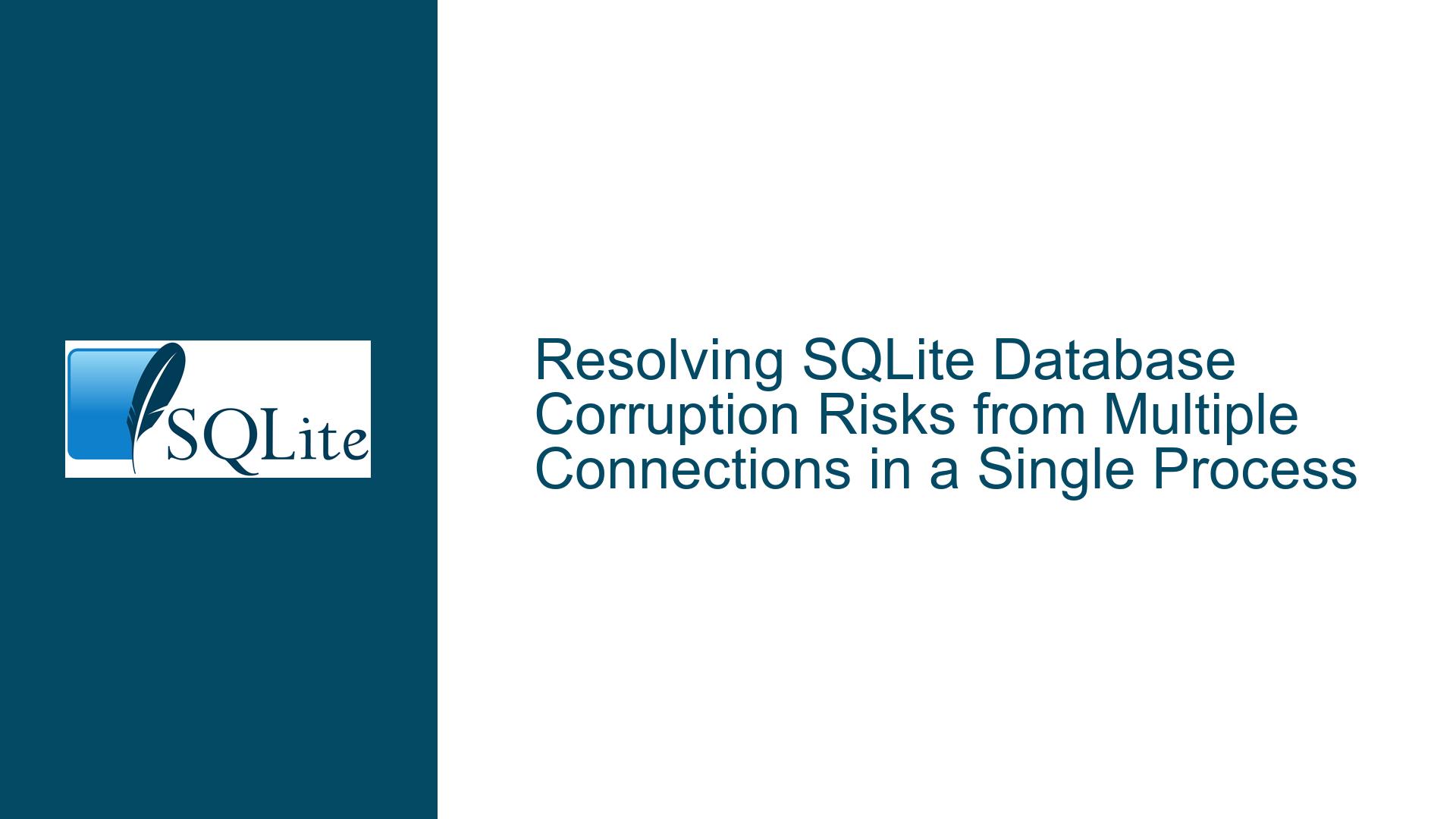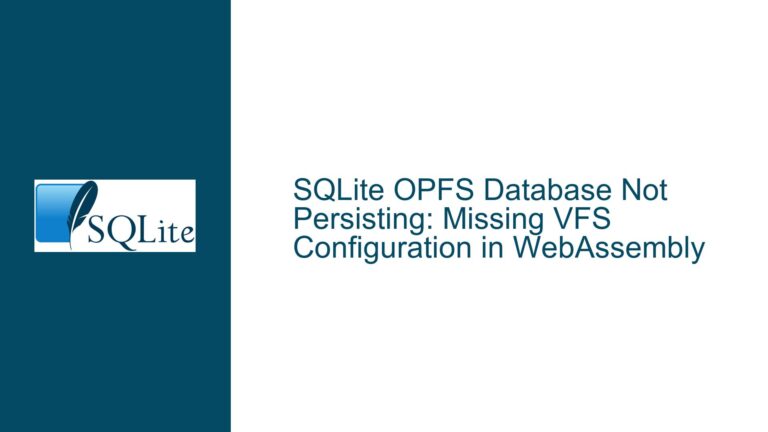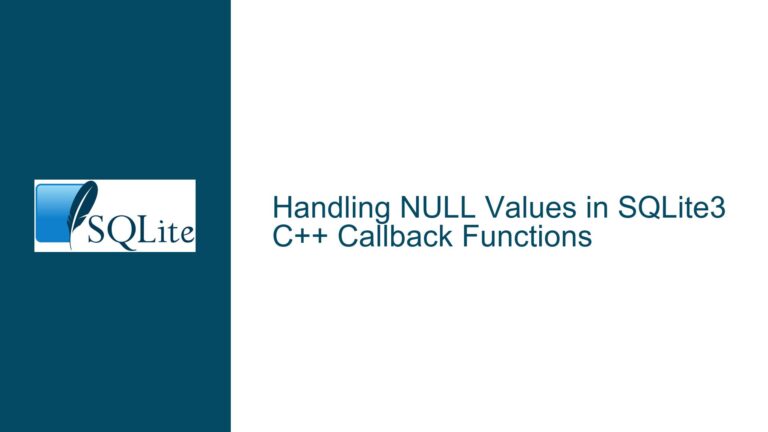Resolving SQLite Database Corruption Risks from Multiple Connections in a Single Process
Understanding SQLite’s Multi-Connection Behavior and Corruption Risks
Issue Overview
SQLite is designed to support multiple concurrent connections to the same database file within a single process, but this capability comes with critical caveats. The confusion arises from two seemingly contradictory aspects of SQLite’s documentation:
- The warning in "How To Corrupt An SQLite Database File" about potential corruption when multiple instances of the SQLite library are linked into the same application.
- The existence of "Shared-Cache Mode", which explicitly allows multiple connections from the same thread or process to share a common cache.
The core issue lies in distinguishing between connections (logical handles to a database) and library instances (separate copies of the SQLite codebase linked into the same process). When multiple copies of the SQLite library exist in a process (e.g., due to static linking in different modules), each maintains its own global list of database connections. These isolated instances cannot coordinate locks or transaction states, leading to scenarios where one connection might inadvertently override another’s locks, corrupting the database. Shared-cache mode, on the other hand, operates under a single library instance and centralizes schema and data caching across connections, reducing redundancy. However, it imposes significant restrictions, such as requiring all connections to reside in the same thread unless configured for multi-threaded use.
The risk of corruption is not inherent to having multiple connections but stems from improper management of library instances, threading, and locking mechanisms. Applications that naively open connections across subsystems without ensuring they share the same SQLite library instance or that misuse shared-cache mode in resource-rich environments are particularly vulnerable.
Root Causes of Database Corruption in Multi-Connection Scenarios
Possible Causes
Multiple SQLite Library Instances in a Single Process
When an application links to multiple copies of the SQLite library (e.g., via static linking in separate dynamically loaded modules), each library instance maintains an independent global list of open database connections. These instances cannot coordinate POSIX advisory locks, which SQLite relies on for transaction control. Aclose()operation on a connection from one library instance might release locks held by a connection from another instance, leaving the database in an inconsistent state.Misconfigured Shared-Cache Mode
Shared-cache mode allows multiple connections to share a single cache, but it requires strict adherence to threading rules. If connections are opened in different threads without enabling multi-threaded support (SQLITE_CONFIG_MULTITHREAD), cached data may become inconsistent. Additionally, shared-cache mode disables the "write-ahead log" (WAL) by default, forcing connections to use rollback journals, which are less resilient to concurrent write attempts.POSIX Advisory Locking Limitations
SQLite uses POSIX advisory locks to coordinate access between connections. If two connections from different library instances attempt to modify the database simultaneously, they may bypass each other’s locks, leading to overlapping writes. This violates SQLite’s isolation guarantees and can corrupt indices, trigger false constraint violations, or leave partially written pages.Uncoordinated Transaction States
Connections from separate library instances cannot track each other’s transaction boundaries. For example, ifConnection A(fromLibrary Instance 1) starts a transaction andConnection B(fromLibrary Instance 2) attempts a write without acquiring an exclusive lock, the two transactions may interleave their changes, bypassing SQLite’s atomic commit logic.Thread-Safety Misconfigurations
SQLite offers three threading modes: single-thread, multi-thread, and serialized. If the library is compiled in single-thread mode but used in a multi-threaded application, connections opened in different threads may corrupt internal data structures. Even in multi-thread mode, sharing connections across threads without mutexes can lead to race conditions.
Mitigation Strategies and Best Practices for Safe Multi-Connection Usage
Troubleshooting Steps, Solutions & Fixes
1. Ensure a Single SQLite Library Instance Per Process
- Audit Linking Configuration: Verify that all components of the application dynamically link to the same SQLite shared library. For statically linked codebases, ensure no duplicate copies of SQLite are embedded in plugins or modules.
- Use Process-Wide Connection Registry: Maintain a global registry of open database connections within the process. Before opening a new connection, check if an existing connection to the same database can be reused or shared.
2. Avoid Shared-Cache Mode Unless Necessary
- Resource Requirements: Shared-cache mode is optimized for environments with extreme memory constraints (e.g., embedded systems). In most applications, standard connections with WAL mode provide better performance and concurrency.
- Thread Constraints: If using shared-cache, ensure all connections are created in the same thread or enable multi-threaded support via
sqlite3_config(SQLITE_CONFIG_MULTITHREAD)before opening any connections.
3. Implement Connection Pooling Correctly
- Reuse Connections: Instead of opening and closing connections frequently, use a connection pool with a fixed number of long-lived connections. This reduces contention over locks and minimizes the risk of stale file descriptors.
- Isolate Write Operations: Dedicate specific connections for write transactions and serialize access to them using mutexes. Read-only connections can operate concurrently in WAL mode.
4. Separate Databases for Independent Subsystems
- If subsystems operate on unrelated tables (as in the user’s case), splitting them into separate database files eliminates cross-connection contention. Use
ATTACH DATABASEto combine them logically when needed.
5. Enable Write-Ahead Logging (WAL)
- WAL mode allows concurrent reads and writes by separating transaction logs from the main database file. Enable it using:
PRAGMA journal_mode=WAL; - WAL reduces the frequency of lock conflicts and improves performance in multi-connection scenarios.
6. Enforce Thread-Safe Practices
- Compile SQLite in serialized threading mode (
-DSQLITE_THREADSAFE=1) to allow safe sharing of connections across threads. - Use thread-local storage for connections that must remain isolated. For example, in Go’s
sqlitexpool, connections are bound to goroutines viaruntime.LockOSThread().
7. Monitor Locking States
- Use
sqlite3_db_status()withSQLITE_DBSTATUS_LOOKASIDE_USEDto monitor lock contention. - Log lock acquisition failures and retry transactions with exponential backoff to mitigate transient conflicts.
8. Validate Database Integrity
- Periodically run
PRAGMA integrity_check;to detect corruption early. - Enable checksum verification using
PRAGMA page_checksum=1;(requires SQLite 3.32.0+).
9. Backup and Recovery Protocols
- Use online backups via
sqlite3_backup_init()to create snapshots without blocking the main database. - Configure automatic checkpointing in WAL mode to limit log file growth:
PRAGMA wal_autocheckpoint=1000; -- Checkpoint after 1000 pages
10. Diagnose Library Instance Conflicts
- To detect multiple library instances, compare the memory addresses of SQLite functions (e.g.,
sqlite3_open_v2) from different modules. - In Unix-like systems, use
dladdr()to resolve the library path of SQLite symbols.
11. Transaction Isolation Techniques
- Use
BEGIN IMMEDIATEorBEGIN EXCLUSIVEtransactions for write operations to acquire locks early. - Keep transactions short to minimize the window for lock conflicts.
12. File Descriptor Management
- Ensure the process limit for open files (
ulimit -n) is sufficiently high to accommodate all connections. - Close idle connections promptly to prevent resource exhaustion.
By adhering to these practices, developers can safely leverage multiple connections within a single process while mitigating the risk of database corruption. The key is to centralize SQLite library usage, enforce thread safety, and adopt modern features like WAL mode to handle concurrency gracefully.






